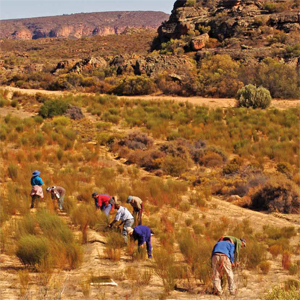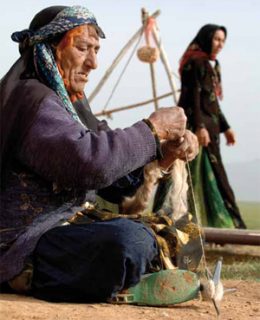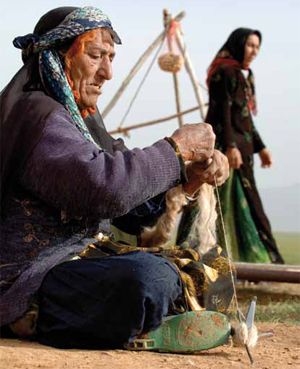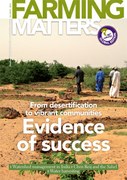The United Nations Convention to Combat Desertification, UNCCD, is celebrating its first 18 years in 2012, which means that, according to UN definitions, it has now reached adulthood. This provides a perfect opportunity to turn on the spotlights and look at the period covering the Convention’s childhood and youth – and to present recommendations for an even more successful adulthood.

Looking back at the past 18 years, we see many problems and challenges in terms of desertification and land degradation. But we also see three promising trends and, as members of Drynet, we feel proud to have helped shape them.
The first is that, despite serious difficulties in terms of governance in many areas, with conflicts over tenure and insecurity over land-use rights, we see that participatory processes in the management of natural resources are becoming stronger.
Local people are taking control over their surroundings and livelihoods by actively taking part in these management efforts, making suggestions, and developing and sharing their know-how and expertise.
At the same time, the discourse about agriculture is changing. Pushed and pulled by food crises and deadlocks, agriculture and its linkages to rural development are back on the agenda of the world’s decision makers. Presented as agro-ecology, sustainable agriculture by small-scale farmers is receiving more and more attention in scientific and policy discussions.
Thirdly, many grassroots sustainable initiatives, in drylands and areas that suffer from desertification, are gaining attention and recognition – and providing interesting lessons and recommendations. The following are just a few examples of what is happening in many places.
Nomadic pastoralists
In Iran, rangelands used to be used and managed by nomadic pastoralists, relying on their traditional norms, customary practices, indigenous knowledge and spiritual beliefs. But since the 1963 Agrarian Reform and the nationalisation of all natural resources, the management of these rangelands has been taken over by an expensive government system. Unfortunately, this path has proven unsuccessful, due to a lack of participation from the users of these resources – the nomadic pastoralists. Over the years, this has resulted in a loss of biodiversity and the complete degradation of the rangeland ecosystem.
Responding to these difficulties, the Centre for Sustainable Development (CENESTA) has been working with various nomadic pastoralist groups (the Bakhtiari, Qashqai, Shasevan and Abolhasain), helping them reclaim their rights, use the land sustainably and conserve natural resources. We start from the understanding that drylands are non-equilibrium ecosystems.
This means that they regularly change between different ecological states. Nomadic pastoralists are the ones who know how to detect these patterns and cycles. When policy makers acknowledge this, they implicitly validate the importance of indigenous knowledge and its essential role in the sustainable management of dryland resources.
The research activities resulting from our partnerships have helped all the stakeholders to recognise:
- that seasonal migration is a historical management strategy;
- the importance of strengthening traditional and indigenous governance and management systems;
- the need to promote indigenous knowledge related to conservation and sustainable land management and use; and
- the need to improve the managerial and executive capacities of nomadic communities.
Most importantly, policy-makers now acknowledge that a different approach is needed: one that is based on the participation of indigenous and local communities, and that combines indigenous knowledge with the latest scientific findings about sustainable land management.
Saffron flowers

The community of Çütlük lies in south-east Turkey, close to Syria and Iraq. Local agriculture is dominated by irrigated cotton, which has resulted in increased levels of soil salinity and the loss of nutrients.
In 2003, the Turkish Foundation for Combating Soil Erosion, for Reforestation and the Protection of Natural Habitats (TEMA) and Harran University explored the potential to reintroduce the production of saffron, one of the most expensive spices in the world, and a crop that used to be cultivated in the area in the 19th century.
Saffron grows wild around Çütlük and offers great potential for local value-addition. Equally interesting, saffron production requires only 10% of the water needed to produce cotton.
TEMA and the university worked with the villagers, carrying out soil tests and offering a complete training package, with access to bulbs and the facilities to store them. The farmers who started cultivating saffron doubled their incomes and their social status within the community improved, especially in the case of female farmers. In addition, far less water was used for irrigation and the soils showed signs of recovery.
The transition from cotton to saffron made agricultural practices in the area more sustainable, led to the development of small enterprises and improved villagers’ social, economic and educational opportunities. Other communities in the region noticed the benefits and a number of similar projects have been established. These projects have shown the economic and ecological benefits of replacing an imported crop with an indigenous one, adapted to the dryland environment, and highlight the value of biodiversity in drylands. (Unfortunately, some projects have come to a halt due to the construction of dams and the expansion of irrigation in the area, which made the production of saffron no longer possible.)
Sustainable rooibos production
Rooibos tea is indigenous to the Western Cape province of South Africa. It does not require irrigation and is very hardy, and is thus an ideal source of income for small-scale farmers in drylands. Following the apartheid era and the deregulation of the rooibos industry, low prices resulted in an acute problem for small-scale farmers: their returns no longer covered their production costs.
In 1998, the Department of Agriculture asked two local organisations, INDIGO and EMG, to engage with communities in the Suid Bokkeveld region and look for alternatives. After a fact-finding trip to producers selling organic rooibos, 12 community members decided to form an organic rooibos co-operative. In 2001, the Heiveld Co-operative for organic rooibos was founded, first selling via middlemen and later benefitting from the Fair Trade and organic labels.
Aside from cultivated rooibos, wild rooibos grows in Suid Bokkeveld in undisturbed natural areas. This used to be harvested by landless people. The Heiveld Co-operative worked with these harvesters and EMG to establish sustainable harvesting standards for wild rooibos. The cooperative markets this exceptionally high quality, biodiversity- friendly product for an even higher premium, providing an incentive for the community to protect the natural areas as a biodiversity reservoir. These standards are now being adopted in other areas where rooibos grows wild.
Recently, after a severe drought, 80% of the cultivated rooibos died while the wild rooibos survived. In the light of current concerns about climate change, this underlines the importance of maintaining wild stock and keeping a wider range of options open for the future. The Heiveld Co-operative now has 56 members, and has established an international reputation for reliably delivering a high quality product.
All the examples above originated from civil society organisations (CSOs) that are now part of the international network called Drynet. Drynet was formed in 2007, when 14 CSOs from all over the world joined forces in order to counter the degradation of drylands. Drynet showcases successful grassroots responses to dryland problems and encourages the up-scaling of successful initiatives and their dissemination to other areas.
Over the years, Drynet has succeeded in making its voice heard in international policy and scientific fora. Drynet also offers participating CSOs the opportunity to share their experiences and knowledge with different communities, and to develop their skills base. This gives participating CSOs more knowledge about sustainable practices and local initiatives on the ground, and more confidence in their dealings with decision makers.
During the past five years, Drynet has shown the importance of working with communities living in the world’s drylands and the need to involve them in all development and planning processes.
In addition, the network has put sustainable solutions for degradation and drylands onto national and international agendas. Our 18th birthday present to the UNCCD is a set of recommendations resulting from these experiences.
Our gift to the UNCCD
Convinced of the benefits of the approaches our partners are following, we recommend UNCCD to ground its scientific discussions around three areas:
(a) Agro-ecology
- Invest in participatory research systems, local knowledge and agro-ecological practices to improve livelihoods and production in drylands. Combine the best of two worlds: traditional practices and knowledge with scientific and formal knowledge
- Focus, in the first instance, on the people living in drylands; on local markets and food demand, then on regional markets. Only then look further afield.
(b) Local knowledge
- Get a better insight into the realities in the field and learn from local experiences. Invest in things that have proven to be a success. Emphasise the importance of bottom-up approaches, grassroots movements and farmer-to-farmer exchanges and communication;
- Tackle the obstacles to up-scaling by improving evaluation, documentation and communication of good practices and local success stories. If “seeing is believing”, then exchange visits are more inspiring than stories on paper.
(c) Governance
- Promote greater participation in the management of natural resources and in decision making about ecosystems;
- Use the Right to Food as a guiding principle. Develop sustainable governance systems for the tenure of land. The voluntary guidelines developed by the UN Committee on Global Food Security are an ideal starting point for reviewing and improving tenure, land management and spatial planning.
We congratulate the UNCCD on reaching maturity; it is now ready to take on much more responsibility. Participation of people in drylands management, cherishing sustainable initiatives, and building more and stronger partnerships between land users, governments, NGOs, science and the private sector, are the key elements to follow. We know that wisdom is there, and we wish UNCCD lots of courage and success. Cheers to the future of UNCCD and to people living in drylands!
Patrice Burger, Nathalie van Haren, Duygu Kutluay, Nahid Naghizadeh and Khadija Razavi
Patrice Burger is the Executive Director of CARI, France (www.cariassociation.org) and a member of the UNCCD’s roster of drylands experts.
Nathalie van Haren works as Senior Policy Officer at Both ENDS, the Netherlands (www.bothends.org).
Duygu Kutluay is the International Relations Officer at TEMA, Turkey (www.tema.org.tr).
Nahid Naghizadeh works as Programme Officer for Community- Based Natural Resource Management for CENESTA, Iran (www.cenesta.net).
Khadija Razavi is CENESTA’s Executive Director. These are all member organisations of Drynet (www.dry-net.org).


